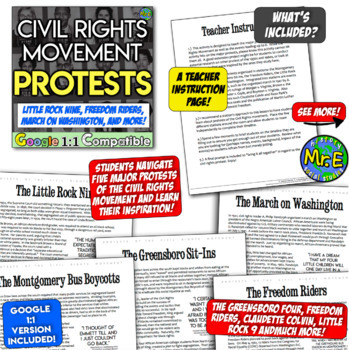Civil Rights Movement Stations Activity Lesson | Freedom Riders, Little Rock 9
- Zip
- Google Apps™

What educators are saying
Also included in
- In this product bundle, you receive 3 outstanding resources to celebrate and honor Martin Luther King, Jr. Day. 1.) A history of the MLK holiday resource is used to highlight the life and achievements of Dr. Martin Luther King, Jr. This resource includes engaging class text, a timeline assignment,Price $9.99Original Price $12.98Save $2.99
Description
This Civil Rights Movement stations activity resource engages students on the Freedom Riders, the Little Rock 9, the Montgomery Bus Boycott, the Greensboro Sit-Ins (and the Greensboro Four), the March on Washington, and more!
This top-notch resource is included in the Civil Rights Movement Unit Bundle!
In this hands-on and engaging lesson, students investigate five major Civil Rights Movement protests to understand the different methods of protests used to gain civil, political, and economic freedoms for African-Americans.
There are five major protests organized in stations: the Montgomery Bus Boycott, the Greensboro Sit-Ins, the Freedom Riders, the Little Rock Nine, and the March on Washington. Integrated into stations are events that led to these protests, such as the organized march in 1941 by A. Philip Randolph, the court rulings of Morgan v. Virginia, Brown v. the Board of Education, Browder v. Gayle, and Boynton v. Virginia. Also integrated are major events such Claudette Colvin and Rosa Park's refusal to give up their bus seats and the publication of Martin Luther King's memoir, Stride Toward Freedom. Students navigate between the engaging material to complete a hands-on timeline activity where they learn more about the major events and what inspired each to take place.
A final student prompt is also included to highlight the powerful use of protest in the Civil Rights Movement. Teacher instructions and a teacher key are also included!
Wish to use this through Google Classroom? This lesson is already Google 1:1 compatible -- everything is ready to go in your download!
----
Check out other hands-on products to engage your students on the Civil Rights Movement:
☆ The Tragic Story of Emmett Till: A Four-Step, Multi-Faceted Activity!
☆ Civil Rights Movement Protests: Freedom Riders, Greensboro 4, Little Rock 9, & more!
☆ Martin Luther King Speeches: "I Have a Dream" compared to "I've Been to the Mountaintop."
☆ Plessy v Ferguson, Jim Crow Laws, & how "Separate Was Inherently Unequal."
☆ The Bravery of Ruby Bridges: Students understand the courage of Ruby Bridges!
--
Be sure to follow the History with Mr E Facebook page, and don't forget to signup for the Social Studies Newsletter to receive information on flash sales, product releases, and classroom tips!






